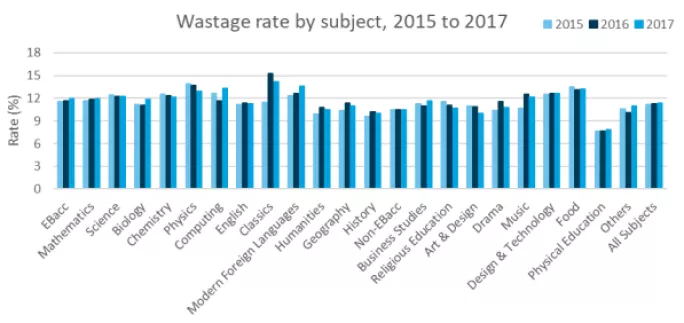Today the government published new data analysing recruitment, retention and training within the state school teaching workforce.
Here’s five things we learned:
1. ‘Out of service’ rate increases across all subjects
Teachers going ‘out of service’ refers to those leaving the state sector for reasons other than retirement or death.
The data published today shows that the out of service rate increased in every subject between 2015 and 2017, with the overall secondary increase being 1 percentage point
The largest increases were seen in classics (3 percentage points) and modern foreign languages (1.8 percentage points), with the smallest increases coming in chemistry (0.2 percentage points) and art & design (0.3 percentage points).
2. Secondary teacher ‘wastage’ rate up
The ‘wastage rate’ is defined as the percentage of teachers in a subject identified as having left the profession (for any reason) divided by the total number of teachers teaching the subject.
Between 2015 and 2017 the overall wastage rate for secondary schools increased by 0.2 percentage points, from 11.2 per cent in 2015 to 11.4 per cent in 2017.
The subjects which had the largest wastage rates in 2017 were classics (14.2 per cent) and modern foreign languages (13.6 per cent), which both saw large increases in the wastage rate since 2015 (2.7 and 1.3 percentage points respectively).
The subject with the lowest wastage rate in each year was physical education (7.8 per cent in 2017) while the subjects which saw the biggest fall from 2015 to 2017 were physics and art & design (both 1 percentage point).
3. Number of secondary teachers has plateaued
Using information from the teachers’ pension scheme, the analysis looks at the number of teachers at primary and secondary level.
While the number of primary teachers increased at the same pace between 2010 and 2015, the number of secondary teachers has plateaued since 2010. But demand is about to rocket.
The number of primary school pupils has risen since 2009, which increased the number of primary teachers needed. This “bulge” is now making its way into secondary schools.
4. Teacher leavers are seasonal
According to the DfE data, there are three spikes of teacher leavers every year in March, August and December, with the highest peak in August at the end of the school year.
There are also three spikes every year for both entrants and returners: April, September and December with the highest peak in September - the start of the school year.
5. Young female NQTs are more likely to remain in the profession
Newly qualified teachers who are female had a higher retention rate after five years than male NQTs, by 5 percentage points.
Younger NQTs (those under 30) were also more likely to be in service after five years, with a higher retention rate of 3 percentage points.









